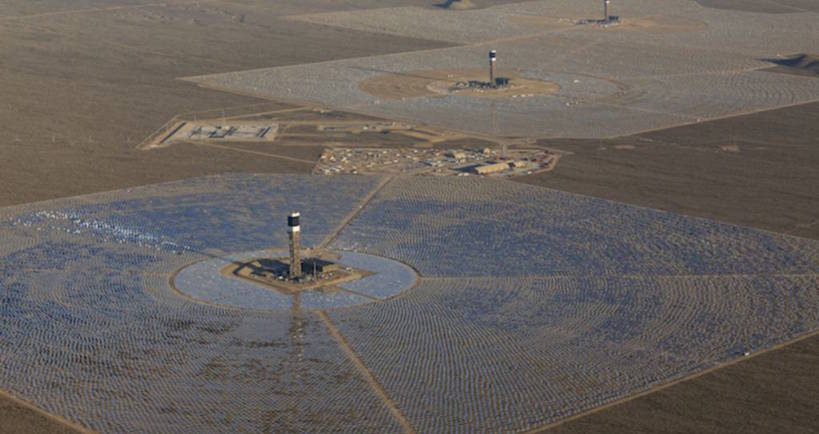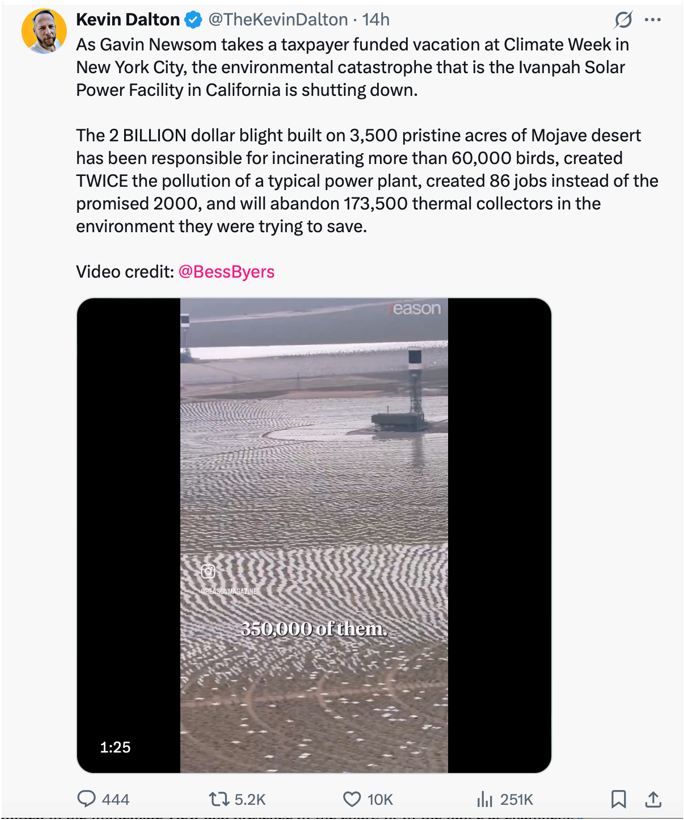
California’s Failed $2.2B Ivanpah Solar Power Facility is Shutting Down
California has the most expensive and least reliable electricity
By Katy Grimes,
California has taken nuclear power plants offline while increasing mandates for wind and solar, resulting in statewide power shortages and power outages. Nuclear power is clean and reliable; wind and solar power, while “clean,” are unreliable, significantly more expensive, and emit the dreaded greenhouse gases (but don’t tell anyone that part).
There have been power outages since the 2006 California Global Warming Solutions Act, AB 32, was passed by the Legislature and signed into law. The California Public Utilities Commission has rejected previous attempts, but following the deadly 2018 fires, allowed power shutoffs under the guise of protecting public safety.
And now, one of the largest solar projects and bird killers is quietly shutting down. The $2.2 billion Ivanpah Solar Project in the Mohave Desert, which received $1.6 billion dollars in federal loan guarantees from the Obama administration, is shutting down. Larger than the Obama Solyndra solar scandal, the Ivanpah project is another California boondoggle that harmed the environment more than it provided much needed electricity to the state’s 40 million residents.
And Ivanpah incinerates more than 6,000 birds a year.
Besides AB 32, in 2011, California passed the Renewables Portfolio Standard setting the mandate at 33 percent renewable energy by 2020. When it became clear that California was nearly there, in 2015, the Legislature moved the bar again and passed SB 350 the “Clean Energy and Pollution Reduction Act of 2015.” SB 350 requires the state to procure 50 percent of electricity from renewable energy and double energy efficiency savings by 2030. In 2018, Gov. Jerry Brown signed Senate Bill 100, setting a 100 percent clean electricity goal for the state, and issued an executive order establishing a new target to achieve carbon neutrality – both by 2045. These mandates leave utility companies no wiggle room.
The Legislature continues to move the bar, justifying more failing clean energy projects.
Using more renewable energy causes the entire electricity grid to be unreliable because sun and wind are intermittent and inconsistent. And, energy costs in California are among the highest in the nation, and only continue to increase due to California’s mandates of renewables in electricity production.
Only one year after adopting SB 350, the announcement in 2016 from PG&E that it was closing Diablo Canyon Nuclear Power Plant ironically came on the same day there were rolling blackouts in Los Angeles amidst sweltering temperatures. PG&E said they planned to replace the loss of the cheap, clean nuclear energy with renewable energy, the Globe reported in 2019.
How did that work out?
“As Gavin Newsom takes a taxpayer funded vacation at Climate Week in New York City, the environmental catastrophe that is the Ivanpah Solar Power Facility in California is shutting down,” Kevin Dalton posted to X. “The 2 BILLION dollar blight built on 3,500 pristine acres of Mojave desert has been responsible for incinerating more than 60,000 birds, created TWICE the pollution of a typical power plant, created 86 jobs instead of the promised 2000, and will abandon 173,500 thermal collectors in the environment they were trying to save.”

In a nutshell, he is so right.
California has the most expensive electricity west of the Mississippi River in the continental U.S., and has the least reliable electricity, Forbes reported six years ago. “California easily leads the nation with nearly 470 power outages a year, compared to 160 for second place Texas, which is really amazing because Texas produces 125% MORE electricity! (here).”
“California’s reliability problems will be multiplied as more wind and solar enter the power mix, intermittent resources located in remote areas that cannot be so easily transported to cities via the grid.”
According to the Department of Energy, “Ivanpah uses power tower solar thermal technology to generate power by creating high-temperature steam to drive a conventional steam turbine. Mirrors are used to concentrate sunlight and create steam, which is then converted to electricity.”
And here we are, shutting down the multi-billion dollar solar project because it just doesn’t produce the electricity expected and still relies on natural gas to even remain functional.
In January, PG&E announced it would stop buying power from the Ivanpah solar facility. Ivanpah was slated to run until 2039, Marc Morano with Climate Depot reported in February.
Morano continued:
According to Department of Energy, “the cost of electricity from concentrating solar power has dropped more than 50 percent in 10 years. Supporters of the technology say it could play an important role in cutting emissions because of its ability to store heat for days and act more like baseload power, as well as replace some fossil-fuel-heavy industrial processes that rely on high heat. With predictions of surging electricity demand in years ahead, it’s important to continue developing new power options, they say. The National Renewable Energy Laboratory in Colorado is among the entities researching ways to bring down costs of concentrating solar.”
“But Jenny Chase, a solar analyst at BloombergNEF, said the prospect for solar thermal plants like Ivanpah is poor, since existing solar projects have historically underperformed. Ivanpah never generated more than 75 percent of its planned electricity output in a year, she said. That’s partly because the technology is unwieldy with a lot of moving parts, she said.”
Just about every impulsive, crazy clean energy project the left has dreamed up and foisted on the American public has failed, or dramatically underperformed – the electric car versus the internal combustion engine car; solar power cannot replace clean natural gas or abundant coal power.
The weird guy in my neighborhood who used to drive a vegetable oil powered 1970’s Mercedes is just one example.
Author – Katy Grimes
Katy Grimes, the Editor in Chief of the California Globe, is a long-time Investigative Journalist covering the California State Capitol, and the co-author of California’s War Against Donald Trump: Who Wins? Who Loses?
From californiaglobe.com